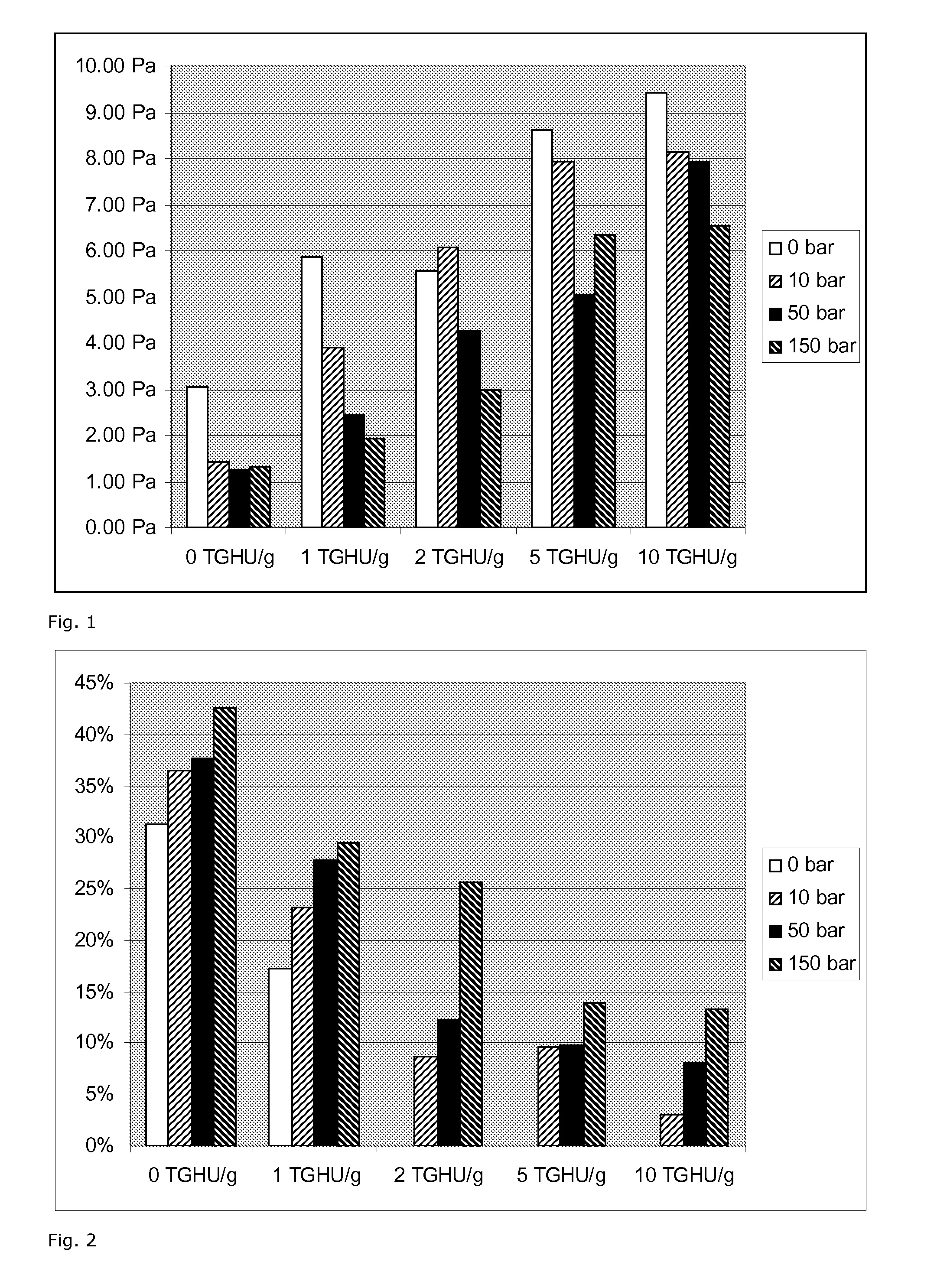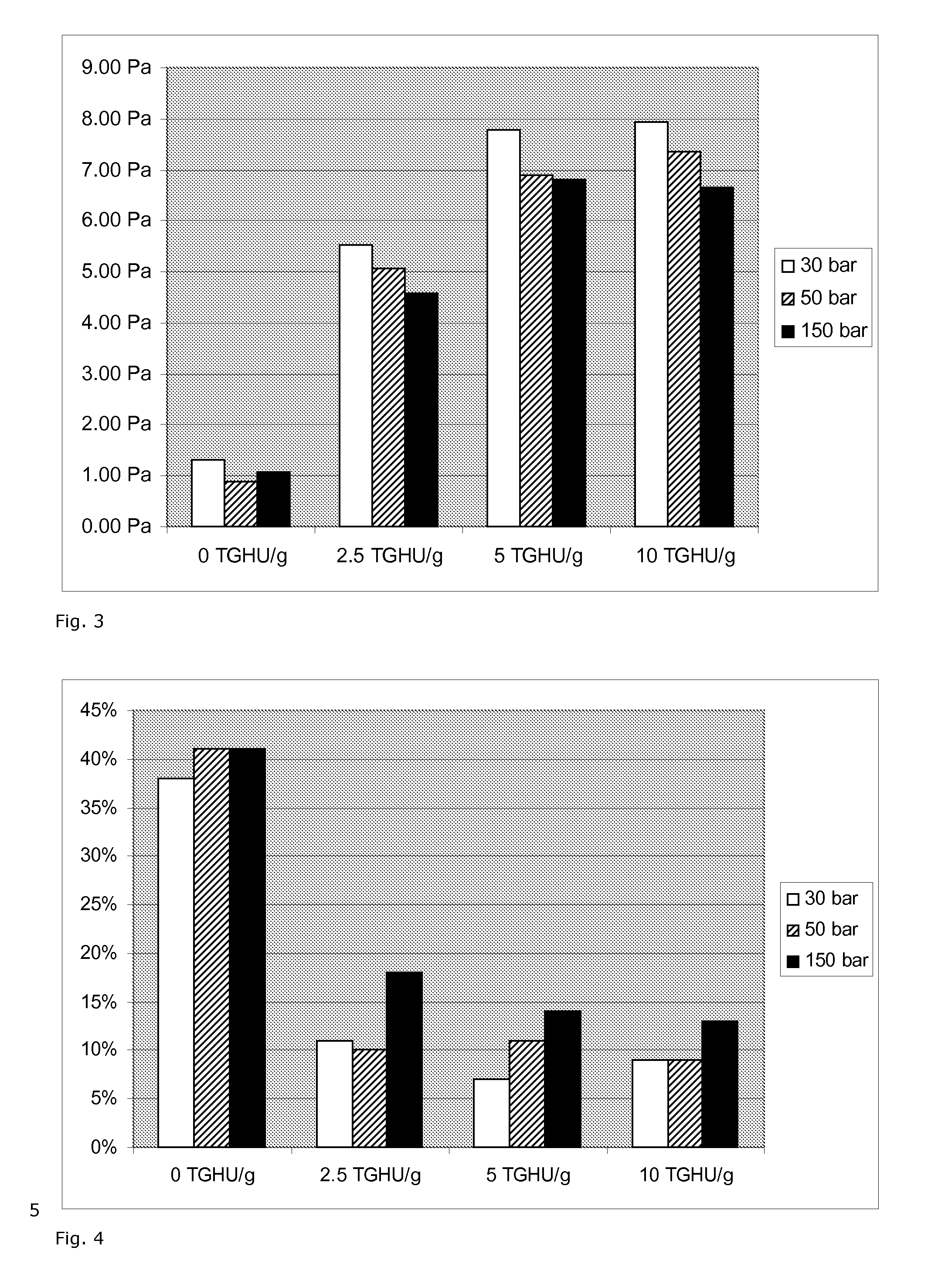Method for producing an acidified milk product
- Summary
- Abstract
- Description
- Claims
- Application Information
AI Technical Summary
Benefits of technology
Problems solved by technology
Method used
Image
Examples
example 1
Preparation of Acidified Milk Drink Samples and Measurement of Viscosity
Skmp Solution (Skim Milk Powder Solution)
[0103]600 ml water+135 g skim milk powder (instant dispersibility from Kerry, Ireland) was incubated at 50° C. for 10 min before use, so a homogeneous solution was obtained.
Sugar Solution
[0104]33 g sucrose
105 g glucose
[0105]These sugars were added to 460 ml 20 mM lactic acid buffer, pH 4.0 and incubated at 90° C. for 5 min with stirring and then cooled down to 5° C.
33 g sucrose
2.25 g pectin (Geno pectin YM-1,5-I from CP Kelco)
105 g glucose
[0106]These sugars were added to 460 ml 20 mM lactic acid buffer, pH 4.0 and incubated at 90° C. for 5 min with stirring and then cooled down to 5° C.
[0107]Activa TG (Streptomyces mobaraensis transglutaminase from Ajinomoto, Japan), 1620 TGHU / g, was diluted to give the final concentrations indicated in the Tables. (TGHU=TransGlutaminase Hydroxamate Units).
Procedure
[0108]25 ml SKMP solution was transferred ...
example 2
The Effect of Transglutaminase Treatment Before Pasteurization Using Various SKMP Concentrations
SKMP Solution
[0116]231 ml water+69 g skim milk powder (instant dispersibility from Kerry, Ireland) was incubated at 50° C. for 10 min before use, so a homogeneous solution was obtained.
Sugar Solution
[0117]5.66 g sucrose
18.0 g glucose
[0118]These sugars were added to 46 ml 20 mM lactic acid buffer, pH 4.0 and incubated at 90° C. for 5 min with stirring and then cooled down to 5° C.
[0119]Activa TG (Streptomyces mobaraensis transglutaminase from Ajinomoto, Japan), 1620 TGHU / g, was diluted to give the final concentrations indicated in the Table.
Procedure
[0120]293 ul SKMP solution+0 ul, 82 ul, 189 ul and 457 ul water for sample 1, 2, 3 and 4, respectively, was transferred to 2 ml eppendorf tube. 30 ul Enzyme or water (control) was added and incubation was performed for 120 min at 40° C.
[0121]The solution was incubated at 85° C. for 30 min in a water bath and incubated at 43° C. (water bat...
example 3
Combination of TGase Treatment and Milk Fat or CMC with Final Heat Treatment
Milk
[0127]Arla express milk obtained from supermarket (Bagsvaerd, Denmark) was used:
skimmed milk: 3.5% protein, 4.7% carbohydrate and 0.1% fat;
semi-skimmed milk: 3.4% protein, 4.7% carbohydrate and 1.5% fat; and
full cream milk: 3.4% protein, 4.7% carbohydrate and 3.5% fat.
[0128]The milk was incubated at 95° C. for 5 min before use.
Sugar Solutions
[0129]18% sucrose, 20 mM Lactic acid, pH 4.0.
0.75% CMC, 18% sucrose, 20 mM Lactic acid, pH 4.0.
0.375% CMC, 18% sucrose, 20 mM Lactic acid, pH 4.0.
0.15% CMC, 18% sucrose, 20 mM Lactic acid, pH 4.0.
Enzyme
[0130]Purified GMM S. Mobaraensis (SM) TGase 25 mg / ml was diluted to give the final concentration.
Procedure
[0131]375 ul milk was transferred to 2 ml eppendorf tube. 30 ul Enzyme or water (control) was added, hereafter incubation was performed for 120 min at 40° C.
[0132]The solution was incubated at 85° C. for 30 min in a water bath and hereafter incubated at 43° C. (wa...
PUM
 Login to View More
Login to View More Abstract
Description
Claims
Application Information
 Login to View More
Login to View More - R&D
- Intellectual Property
- Life Sciences
- Materials
- Tech Scout
- Unparalleled Data Quality
- Higher Quality Content
- 60% Fewer Hallucinations
Browse by: Latest US Patents, China's latest patents, Technical Efficacy Thesaurus, Application Domain, Technology Topic, Popular Technical Reports.
© 2025 PatSnap. All rights reserved.Legal|Privacy policy|Modern Slavery Act Transparency Statement|Sitemap|About US| Contact US: help@patsnap.com


